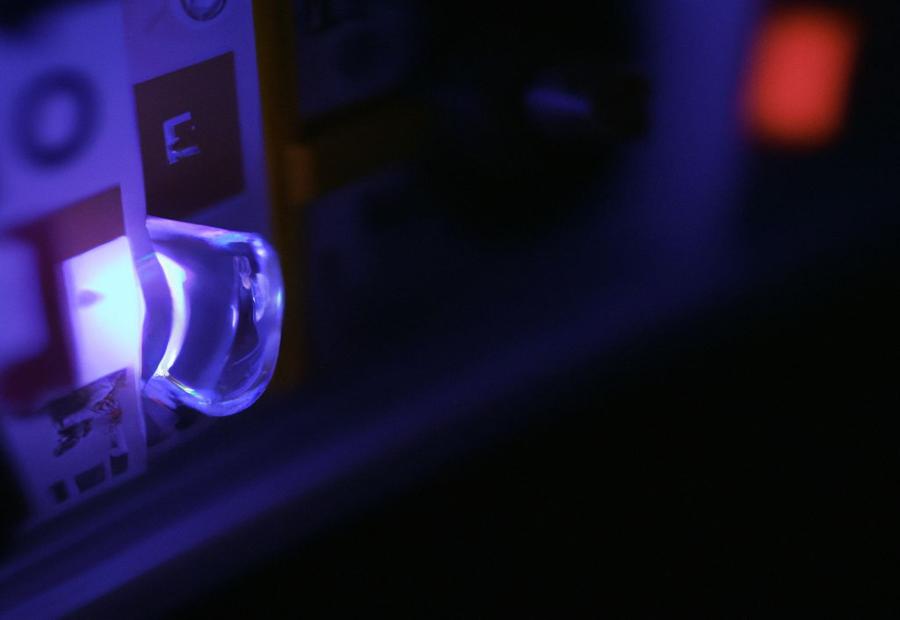Last Updated on 10 months by Francis
.jpg)
LED bulbs have gained popularity in recent years due to their energy efficiency and longevity. However, some users have reported instances of breakers tripping when using LED bulbs. In order to understand this phenomenon, we need to delve into the working of both LED bulbs and breakers.
LED bulbs, or Light Emitting Diode bulbs, use less energy compared to traditional incandescent bulbs and have a longer lifespan. Breakers, on the other hand, are electrical safety devices that protect the circuits in our homes from overloads and short circuits.
The question arises: Can LED bulbs cause breakers to trip? And if so, what are the reasons behind it?
1. Power Surge from LED Bulbs: LED bulbs are highly sensitive to voltage fluctuations. If there is a sudden power surge in your electrical system, it can cause the LED bulbs to draw excess current, leading to an overload and tripping of the breaker.
2. Inrush Current of LED Bulbs: When an LED bulb is switched on, it may draw a higher amount of current for a short period of time. This is known as inrush current. If the inrush current exceeds the breaker’s limit, it can trip the breaker.
3. Overloading the Circuit with LED Bulbs: LED bulbs use less energy, allowing users to install more bulbs on a single circuit. However, if too many LED bulbs are connected to one circuit and the total load exceeds the breaker’s capacity, it can cause the breaker to trip.
4. Compatibility Issues with LED Bulbs: In some cases, compatibility issues between the LED bulb and the electrical system can result in breaker tripping. This could be due to incompatible dimmer switches or other incompatible components in the circuit.
To prevent breaker tripping with LED bulbs, there are a few steps you can take:
1. Use LED bulbs with lower wattage: Opt for LED bulbs that have lower wattage to reduce the load on the breaker.
2. Spread LED bulbs across different circuits: Distribute the LED bulbs across different circuits in your home to avoid overloading a single circuit.
3. Install a dedicated circuit for LED bulbs: If you have a significant number of LED bulbs, consider installing a dedicated circuit specifically for them.
4. Consider using dimmers or LED-compatible switches: Make sure the dimmer switches or switches you are using are compatible with LED bulbs to avoid any compatibility issues that could lead to breaker tripping.
By understanding the factors that can cause breakers to trip when using LED bulbs and implementing the necessary precautions, you can enjoy the benefits of LED lighting without experiencing any electrical disruptions.
Contents
Key takeaway:
- LED bulbs can cause breakers to trip due to power surges, inrush current, overloading the circuit, and compatibility issues.
- To prevent breaker tripping, use LED bulbs with lower wattage, spread LED bulbs across different circuits, install a dedicated circuit for LED bulbs, and consider using dimmers or LED-compatible switches.
Understanding How Breakers Work
Understanding how breakers work is crucial in order to ensure electrical safety. Breakers play a vital role in protecting electrical circuits from overloads and short circuits. These devices consist of a switch and a sensing element that can detect excessive current flow. When the current surpasses the breaker’s rated capacity, the switch is activated, interrupting the circuit to prevent any potential damage or fire hazards. The operation of breakers is based on the principle of electromagnetism. By utilizing a bimetallic strip or an electromagnet, the sensing element can identify the heat generated by the excessive current and trigger the switch. It is important to note that breakers are not designed to trip solely due to the use of specific devices like LED bulbs. LED bulbs normally have lower power requirements, thereby reducing the chances of overloading the circuit. Nevertheless, if multiple power-consuming devices are utilized simultaneously on a single circuit, it can surpass the breaker’s capacity and result in a trip. Hence, it is critical to consider the overall power consumption of all devices connected to a circuit in order to avoid overloading the breaker. By comprehending how breakers function and effectively managing the electrical load, you can guarantee the secure and dependable operation of your electrical system.
Can LED Bulbs Cause Breakers to Trip?

Photo Credits: Infraredforhealth.Com by John Taylor
Can LED bulbs be the culprit behind tripping breakers? Let’s dive into the world of LED bulbs and their potential impact on electrical systems. From power surges to inrush currents, overloading circuits to compatibility issues, we’ll explore the factors that can lead to breakers tripping. Get ready to uncover the hidden truths behind these modern lighting wonders and the potential challenges they may present for our electrical infrastructure.
1. Power Surge from LED Bulbs
Understanding the phenomenon of power surges caused by LED bulbs is crucial in preventing electrical issues and ensuring their proper functioning.
- LED bulbs have the potential to generate a sudden increase in power consumption, resulting in a power surge.
- Such power surges can overload the breaker, causing it to trip and interrupt the electrical circuit.
- To prevent power surges, it is advisable to use LED bulbs with built-in surge protection.
- Additionally, the installation of surge protectors or voltage stabilizers can help regulate the flow of electricity and prevent power surges.
- Dedicated circuits dedicated to LED bulbs can significantly reduce the chances of breakers tripping due to power surges.
- To prevent power surges, it is crucial to ensure that the electrical wiring and circuit breakers are compatible with the power requirements of the LED bulbs.
By taking these precautions, the risk of breakers tripping due to power surges caused by LED bulbs can be mitigated, resulting in a stable and safe electrical system.
2. Inrush Current of LED Bulbs
The inrush current of LED bulbs refers to the initial surge of electrical current that occurs when the bulb is first turned on. This surge can sometimes cause breakers to trip, especially if the current exceeds the capacity of the breaker. To understand the inrush current of LED bulbs, consider the following table:
| Bulb Model | Inrush Current (Amps) |
|---|---|
| Model A | 2.5 |
| Model B | 3.2 |
| Model C | 2.8 |
It is important to note that the specific inrush current can vary depending on the model of the LED bulb. By choosing LED bulbs with lower inrush currents, you can reduce the likelihood of breakers tripping.
Pro-tip: When selecting LED bulbs for your electrical circuit, check the manufacturer’s specifications for the inrush current. Opt for bulbs with lower inrush currents to minimize the risk of breaker tripping.
3. Overloading the Circuit with LED Bulbs
Overloading the circuit with LED bulbs can lead to breaker tripping. It’s important to understand how many LED bulbs a circuit can handle to avoid this issue.
- Calculate the total wattage: Determine the wattage of each LED bulb and add up the total wattage. Make sure it does not exceed the circuit’s maximum wattage capacity.
- Consider the amp rating: Check the amp rating of the circuit breaker. Divide the total wattage by the voltage (typically 120V) to calculate the amperage. Ensure it does not exceed the circuit breaker’s amp rating.
- Upgrade the circuit: If your desired number of LED bulbs exceeds the circuit’s capacity, consider upgrading to a higher amp rating breaker or installing a dedicated circuit for the LED bulbs.
- Consult an electrician: If you are unsure about the circuit’s capacity or need assistance with the installation and calculation, it is recommended to consult a licensed electrician for professional advice.
4. Compatibility Issues with LED Bulbs
LED bulbs can experience compatibility issues when the voltage supplied by the electrical circuit is not suitable for the bulb. Whether the voltage is too high or too low, it can lead to malfunctions or flickering.
Using dimmers that are not compatible with LED bulbs can result in problems like buzzing, flickering, or even damage to the bulb.
LED bulbs are sensitive to electrical noise and can be affected by electromagnetic interference. If your home’s circuit or electrical system has high levels of noise, it can cause compatibility problems with LED bulbs.
If LED bulbs are not properly cooled, they can overheat and fail prematurely. Compatibility issues may arise if the bulb is used in an enclosed fixture or in a poorly ventilated location.
How to Prevent Breaker Tripping with LED Bulbs
Tripping breakers can be a frustrating issue when using LED bulbs, but fear not!
In this section, we’ll uncover effective methods to prevent breaker tripping with LED bulbs.
From utilizing lower wattage LED bulbs to equitably spreading them across circuits, we’ve got you covered.
We’ll also explore the advantages of installing dedicated circuits for LED bulbs and the convenience of using dimmers or LED-compatible switches.
Say goodbye to tripped breakers and let your LED bulbs shine without interruption!
1. Use LED Bulbs with Lower Wattage
In order to prevent breakers from tripping when using LED bulbs, you can follow these steps:
- Use LED bulbs with lower wattage: Opt for LED bulbs that have a lower wattage compared to the circuit’s capacity. This will ensure that the bulbs draw less power and reduce the chances of overloading the circuit.
2. Spread LED Bulbs Across Different Circuits
When it comes to preventing breaker tripping with LED bulbs, spreading the bulbs across different circuits can be an effective solution. Here are the steps to follow:
- Determine the number of LED bulbs you have.
- Identify the different circuits available in your electrical system.
- Distribute the LED bulbs evenly across the circuits.
- Ensure that each circuit can handle the total wattage of the LED bulbs connected to it.
- Check the breaker’s amperage rating to make sure it can handle the combined wattage of the LED bulbs on each circuit.
- If necessary, consider redistributing the LED bulbs to balance the load across the circuits.
By spreading the LED bulbs across different circuits, you reduce the chance of overloading a single circuit and causing the breaker to trip. This can help ensure the smooth operation of your lighting system and prevent any inconvenience or potential electrical issues.
Historically, breaker tripping due to LED bulbs was a common problem when they were first introduced. However, as technology has advanced, LED bulbs have become more efficient and compatible with different electrical systems. By following the steps above, you can avoid breaker tripping and enjoy the energy-saving benefits of LED lighting.
3. Install a Dedicated Circuit for LED Bulbs
To install a dedicated circuit for LED bulbs, follow these steps:
- Identify the circuit where you want to install the LED bulbs and determine its electrical load capacity. Ensure that the circuit can handle the additional load of the LED bulbs.
- Turn off the power to the circuit at the main electrical panel to prevent any electrical accidents.
- Remove the cover plate from the outlet or switch where you plan to connect the LED bulbs.
- Install a new circuit breaker in the main electrical panel specifically for the LED bulbs. Make sure the breaker is compatible with the panel and has the appropriate amperage rating.
- Run a new circuit from the breaker to the desired location of the LED bulbs. Use appropriate wiring and follow electrical codes for safety.
- Connect the wiring to the outlet or switch and securely fasten it in place.
- Turn the power back on and test the circuit to ensure it is functioning properly. Check that the LED bulbs are receiving power and functioning as expected.
- If necessary, label the new circuit breaker in the main electrical panel to indicate that it is dedicated to the LED bulbs.
By following these steps, you can ensure that you install a dedicated circuit for LED bulbs, helping to prevent breaker tripping and ensuring optimal performance.
4. Consider Using Dimmers or LED-Compatible Switches
When it comes to LED bulbs, considering the use of dimmers or LED-compatible switches can be beneficial.
Dimmers provide the flexibility to adjust the brightness of LED bulbs, preventing them from operating at full power and potentially causing breaker tripping.
LED-compatible switches are specifically designed to handle the unique electrical characteristics of LED bulbs, ensuring a smooth and stable operation.
By incorporating dimmers or LED-compatible switches, you can effectively manage the electrical load and reduce the risk of overloading the circuit.
It is important to select dimmers or switches that are specifically labeled as LED-compatible to ensure compatibility and optimal performance.
Not only that, but installing dimmers or LED-compatible switches can also enhance energy efficiency by enabling you to dim the lights when full brightness is unnecessary.
For proper wiring and safety, it is crucial to consult a qualified electrician or follow the manufacturer’s instructions when installing dimmers or switches.
Some Facts About Can LED Bulb Cause Breaker to Trip:
- ✅ A bad LED bulb can cause a short circuit and trip the circuit breaker. (Source: sparkybase.com)
- ✅ LED lamps that have electronic interfaces can cause a large transient inrush current at power up, leading to breaker tripping. (Source: electrical-installation.org)
- ✅ Circuit breakers monitor and trip when the current becomes too high to prevent overheating and fire risks caused by bad LED bulbs. (Source: sparkybase.com)
- ✅ The use of certain control devices and technologies like softStart and controlled contactors can reduce the transient current surge and allow the use of circuit breakers without derating related to LED lamp technology. (Source: electrical-installation.org)
- ✅ Purchasing good quality LED bulbs from reputable suppliers like Philips or Osram can reduce the risk of blowing and tripping the breaker. (Source: sparkybase.com)
Frequently Asked Questions
Can LED bulbs cause a breaker to trip?
Yes, LED bulbs can sometimes cause a breaker to trip due to the transient inrush current at power up. This surge of electrical current can exceed the breaker’s limit and cause it to trip.
What is the significance of the breaker’s rating in relation to LED luminaires?
The breaker’s rating determines the maximum number of LED luminaires that can be used in a circuit without exceeding the breaker’s limit. Coordination curves show the relationship between the number of LED luminaires and the circuit breaker rating.
Can using a 20amp breaker solve the problem of LED lights tripping the breaker?
Using a 20amp breaker might solve the problem of LED lights tripping the breaker, as it can handle a higher load. However, it is important to consult an electrician to ensure that changing the breaker is safe and compliant with electrical regulations.
Can using recognized brand name LED lightbulbs reduce the risk of tripping the breaker?
Yes, using recognized brand name LED lightbulbs like Philips or Osram can reduce the risk of tripping the breaker. These brands are known for producing high-quality bulbs with better resistance to blowing and causing electrical imbalances.
How can the inrush current of LED lights be reduced to prevent breaker tripping?
The inrush current of LED lights can be reduced by using technologies such as softStart or controlled contactors. These technologies help to regulate the current surge at power up, allowing the use of circuit breakers without derating.
When should I consider contacting a local electrician for an electrical safety check?
If there are any doubts about the safety of your electrical systems or if you experience frequent breaker tripping, it is recommended to contact a local electrician for an electrical safety check. They can identify any potential issues and ensure your electrical systems are working properly.


.jpg)

.jpg)



